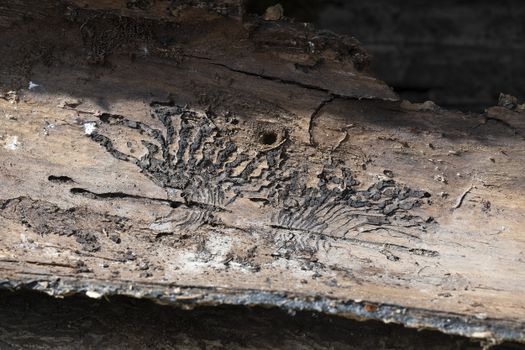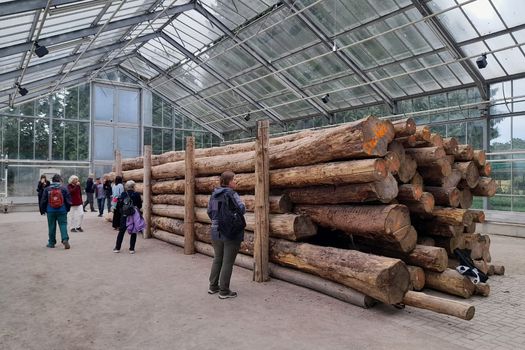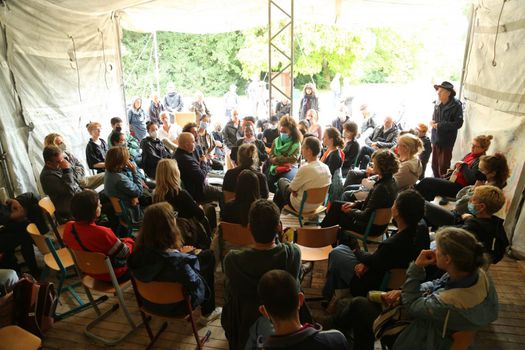The Harvest at Documenta 15, by Sandra Fernández
。。。English translation below 。。。
La resistencia y el reflejo de la otra cara del arte propiciaron un encuentro entre diversos colectivos del mundo. La organización colombiana Más Arte Más Acción reconoció en sus actividades la importancia de juntar visiones hacia el desarrollo sostenible.
Con el ánimo de continuar construyendo a favor de la comunidad, haciendo crecer redes y resistiendo más allá de los 100 días de la Documenta 15, que se desarrolló del 18 de junio al 25 de septiembre, los miembros de Lumbung, ahora y más fuerte que nunca, deciden apostarle a la constante lucha por la igualdad. La Documenta 15 se convirtió en el espacio propicio para justificar que el arte es una herramienta de transformación social capaz de trabajar en conjunto, tejiendo juntos a través de la igualdad y la cosecha de experiencias, recursos, reflexiones y encuentros que buscan fortalecer sus ecosistemas a través de la sostenibilidad.
El ejercicio de recolección de conocimientos basados en las experiencias de los visitantes en consonancia con las actividades de las 14 organizaciones que conformaron los miembros del Lumbung sobrepasó los límites de la institucionalidad para enfocarse en el encuentro de las artes, el activismo y la gestión. “Hemos compartido nuestras luchas y temores. Hemos aceptado la crítica donde se expresaba y hemos hecho la crítica donde se requería; esto nos ha hecho a todos más fuertes y más resistentes. Así es como el arte crea significado, cómo se mueve, cómo debe funcionar y funciona”, dice la comunidad de Lumbung en su declaración, que se dio a conocer el pasado 10 de septiembre.
La experiencia fructífera de reunir en Kassel a diferentes colectivos que mantienen dentro de sus finalidades un compromiso con las comunidades de sus territorios de origen, fue un acercamiento hacia alternativas que fortalezcan la cercanía con la comunidad sin importar su raza, género, etnia, religión, origen, sexualidad o discapacidad. “A veces uno se sentía como el bicho raro en el arte contemporáneo habitual porque todo el mundo hacía exposiciones, cuadros, y acá nos dimos cuenta de que existen redes y personas que están trabajando en lo mismo (…) La idea más bonita de Lumbung es que tiene esa voluntad de seguir más allá”, explica Fernando García, fundador de la plataforma colaborativa española Campo Adentro (Inland), que forma parte de los miembros de Lumbung.

Estas nuevas formas de crear arte con la comunidad se enlazan con el territorio y proponen ampliar el espectro de lo estético para fijarse en las acciones, en el intercambio de saberes y hacer visible lo invisible. La organización colombiana Más Arte Más Acción llevó a Kassel una plataforma móvil (MAMA Doc Space) y la instalación Murmullos de los escarabajos de la corteza; ambas propuestas abrazando reflexiones sobre el cambio climático y la sostenibilidad. Su propósito para la D15 fue llevar proyectos y relaciones vigentes de los colectivos del Chocó que con el tiempo se conectaron juntando visiones y mundos con MAMA, “El ecosistema que llamamos en este momento es con quienes hemos colaborado últimamente y con quienes hemos abordado preguntas y hemos hecho creación artística en los territorios que hemos llegado y con los que hemos conectado por un proceso muy orgánico”, explica Alejandra Rojas, miembro de MAMA.
Con alrededor de 36 eventos que desarrolló MAMA durante la D15, se destaca la actividad “El caminar como diálogos posibles”, un encuentro impartido por el Colectivo COCO, el docente José Fernando Serrano y la investigadora Sina Ribak de Arts Collaboratory. “Diálogos posibles” es un proyecto que se inició en 2019 con el fin de conectar a las comunidades indígenas con el debate climático. En esta actividad se invitó a los visitantes a caminar, experimentar y hablar sobre las relaciones entre la crisis climática de Colombia y Alemania.
“Música y resistencia en el golfo de Tribugá” fue un conversatorio y jam musical sobre los derechos colectivos al territorio, a cargo del músico y líder ambientalista de Nuquí, Enrique González, y dos de los miembros de la Corporación de Músicas Tradicionales Tambacum del golfo de Tribugá.
Se destaca también la participación del Instituto Colombo Alemán para la Paz-CAPAZ y la Comisión de la Verdad con una programación durante el mes de julio a propósito de la publicación del Informe Final de la Comisión de la Verdad en Colombia. “Una de las inquietudes que nos hemos planteado con Atrato Colaboraciones sobre ese modelo de extractivismo del territorio es cómo relacionarlo con el Informe Final de la Comisión de la Verdad con un territorio muy particular, con experiencias de memoria, de resistencias; también desde una perspectiva de los Jóvenes Creadores del Chocó que también se han vinculado al ejercicio de la Comisión”, dice Alejandra Rojas sobre las actividades que se desarrollaron durante una semana.

El comisionado Alejandro Castillejo y el artista Andrés Torres realizaron una lectura ritual del capítulo testimonial del Reporte de la Verdad, además de una sesión de escucha del paisaje sonoro “Murmullos”. También se desarrollaron dos conversaciones: una sobre las prácticas artísticas y de memoria por las comunidades afros del río Atrato que contó con la participación del comisionado Léyner Palacios, Sandra Vega de Jóvenes Creadores del Chocó y Carmenza Rojas de la Fundación Mareia; y la segunda sobre los procesos de memoria histórica en Alemania y Colombia, a cargo de Stefan Peters de CAPAZ, Liliana Gómez de la Universidad de Kassel y el comisionado Léyner Palacios, quien apuntó en la charla: “El arte hace que los jóvenes no entren a la guerra: es un dispositivo para la sanación (…). La guerra nos arrebató la solidaridad y esperamos que la verdad nos recupere esa conciencia”.
Bajo los conceptos de solidaridad, conciencia climática y relación con el territorio, MAMA planteó una serie de actividades académicas en la escuela “El malestar en el extractivismo: Movimientos artísticos y de contracultura”, organizada en colaboración con la Universidad de Kassel, que reflexionó sobre la diversidad ecológica y la extracción de recursos que acontece en América Latina.
Se espera que con las experiencias allí sembradas y los lazos que se construyeron en la D15, MAMA transforme su organización. Es un ciclo que se cierra, pero que continuará tejiendo comunidades y colectivos con sed de sanar, transformar y escuchar.
。。。
In the spirit of continuing to build in favor of the community, growing networks and resisting beyond the 100 days of Documenta 15, which took place from June 18 to September 25, the members of Lumbung, now and stronger than ever, decide to bet on the constant struggle for equality. Documenta 15 became the propitious space to justify that art is a tool for social transformation capable of working together, weaving together through equality and harvesting experiences, resources, reflections and encounters that seek to strengthen their ecosystems through sustainability.
The knowledge-gathering exercise based on the experiences of the visitors in line with the activities of the 14 organizations that made up the members of the Lumbung went beyond the limits of institutionalism to focus on the encounter of arts, activism and management. “We have shared our struggles and fears. We have accepted criticism where it was expressed and made criticism where it was required; this has made us all stronger and more resilient. This is how art creates meaning, how it moves, how it should and does work,” says the Lumbung community in its statement, which was released on September 10.
The fruitful experience of bringing together in Kassel different collectives that maintain within their purposes a commitment to the communities of their territories of origin, was an approach towards alternatives that strengthen the closeness with the community regardless of race, gender, ethnicity, religion, origin, sexuality or disability. “Sometimes you felt like the oddball in the usual contemporary art scene because everyone was doing exhibitions, paintings, and here we realized that there are networks and people who are working on the same thing (…) The most beautiful idea of Lumbung is that it has the will to go beyond,” explains Fernando Garcia, founder of the Spanish collaborative platform Campo Adentro (Inland), which is part of the members of Lumbung.
These new ways of creating art with the community are linked to the territory and propose to broaden the spectrum of aesthetics to focus on actions, the exchange of knowledge and making the invisible visible. The Colombian organization Más Arte Más Acción brought to Kassel a mobile platform (MAMA Doc Space) and the installation Murmullos de los escarabajos de la corteza (Murmurs of the bark beetles); both proposals embrace reflections on climate change and sustainability. Its purpose for D15 was to bring current projects and relationships of the Chocó collectives that over time connected by bringing together visions and worlds with MAMA, “The ecosystem that we call at this time is with whom we have collaborated lately and with whom we have addressed questions and made artistic creation in the territories we have reached and with whom we have connected through a very organic process,” explains Alejandra Rojas, a member of MAMA.
With around 36 events developed by MAMA during D15, the activity “Walking as possible dialogues” stands out, a meeting given by the COCO Collective, teacher José Fernando Serrano and researcher Sina Ribak from Arts Collaboratory. “Possible Dialogues” is a project that began in 2019 with the aim of connecting indigenous communities with the climate debate. In this activity, visitors were invited to walk, experience and talk about the relationships between the climate crisis in Colombia and Germany.
“Music and Resistance in the Gulf of Tribugá” was a discussion and musical jam on collective territorial rights, led by the musician and environmental leader from Nuquí, Enrique González, and two members of the Tambacum Traditional Music Corporation of the Gulf of Tribugá.
The participation of the Colombo-German Institute for Peace-CAPAZ and the Truth Commission also stands out with a program during the month of July in connection with the publication of the Final Report of the Truth Commission in Colombia. “One of the concerns that we have raised with Atrato Colaboraciones about this model of extractivism of the territory is how to relate it to the Final Report of the Truth Commission with a very particular territory, with experiences of memory, of resistance; also from a perspective of the Young Creators of Chocó who have also been linked to the exercise of the Commission”, says Alejandra Rojas about the activities that took place during a week.
Commissioner Alejandro Castillejo and artist Andrés Torres conducted a ritual reading of the testimonial chapter of the Truth Report, as well as a listening session of the “Murmullos” soundscape. Two talks were also held: one on artistic and memory practices by the Afro communities of the Atrato River, which included the participation of Commissioner Léyner Palacios, Sandra Vega of Jóvenes Creadores del Chocó and Carmenza Rojas of the Mareia Foundation; and the second on the processes of historical memory in Germany and Colombia, by Stefan Peters of CAPAZ, Liliana Gómez of the University of Kassel and Commissioner Léyner Palacios, who pointed out in the talk: “Art keeps young people out of war: it is a device for healing (…). The war took away our solidarity and we hope that the truth will recover that conscience”.
Under the concepts of solidarity, climate awareness and relationship with the territory, MAMA proposed a series of academic activities in the school “Unrest in Extractivism: Artistic and Counterculture Movements”, organized in collaboration with the University of Kassel, which reflected on the ecological diversity and resource extraction occurring in Latin America.
It is hoped that with the experiences sown there and the ties built at D15, MAMA will transform its organization. It is a cycle that is closing, but that will continue to weave communities and collectives with a thirst for healing, transformation and listening.

